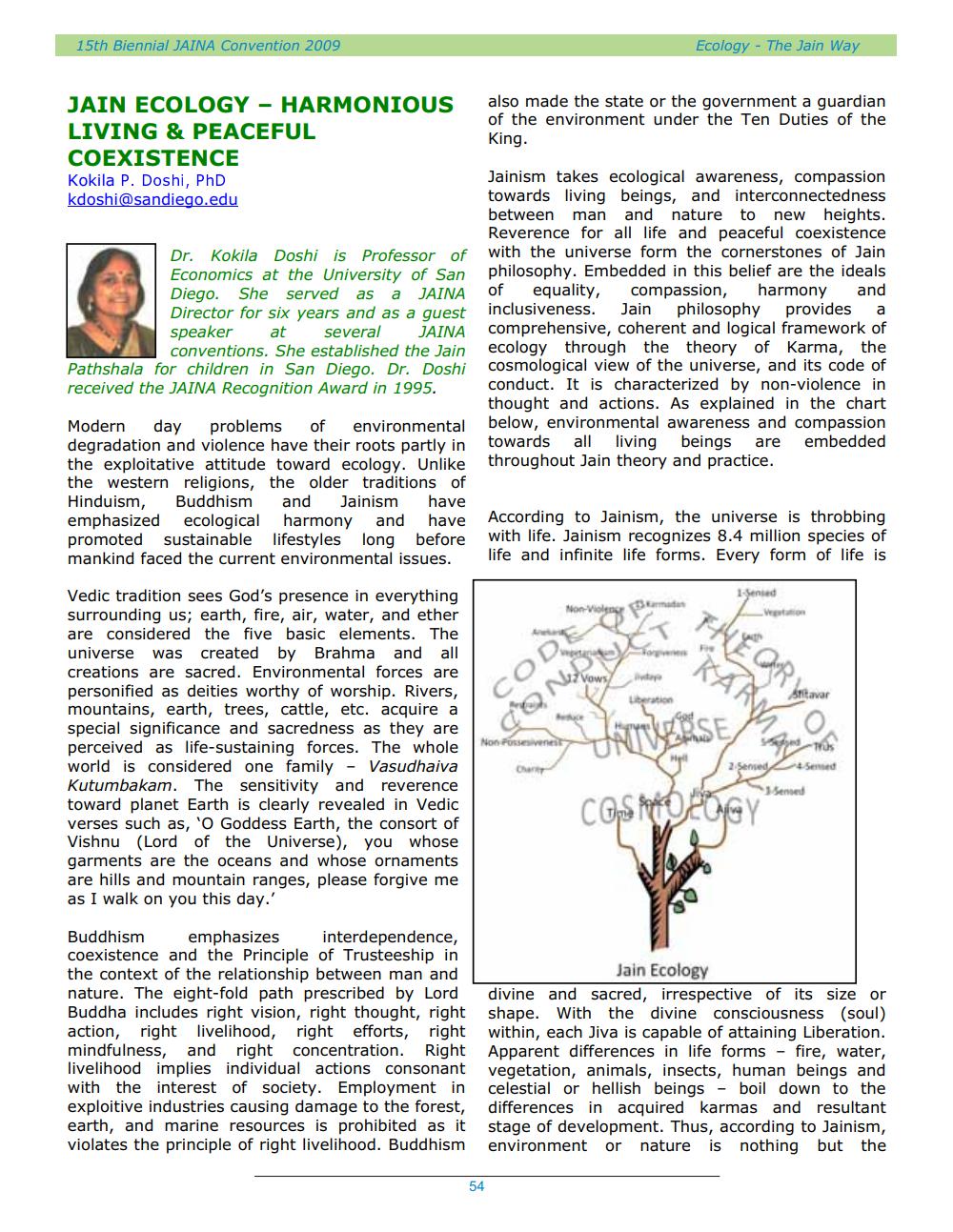________________
15th Biennial JAINA Convention 2009
Ecology - The Jain Way
JAIN ECOLOGY - HARMONIOUS also made the state or the government a guardian
of the environment under the Ten Duties of the LIVING & PEACEFUL
King. COEXISTENCE Kokila P. Doshi, PhD
Jainism takes ecological awareness, compassion
[email protected]
towards living beings, and interconnectedness between man and nature to new heights.
Reverence for all life and peaceful coexistence Dr. Kokila Doshi is Professor of with the universe form the cornerstones of Jain Economics at the University of San philosophy. Embedded in this belief are the ideals Diego. She served as a JAINA of equality, compassion, harmony and Director for six years and as a guest inclusiveness. Jain philosophy provides a speaker at several JAINA comprehensive, coherent and logical framework of
conventions. She established the Jain ecology through the theory of Karma, the Pathshala for children in San Diego. Dr. Doshi cosmological view of the universe, and its code of received the JAINA Recognition Award in 1995.
conduct. It is characterized by non-violence in
thought and actions. As explained in the chart Modern day problems of environmental below, environmental awareness and compassion degradation and violence have their roots partly in towards all living beings are embedded the exploitative attitude toward ecology. Unlike throughout Jain theory and practice. the western religions, the older traditions of Hinduism, Buddhism and Jainism have emphasized ecological harmony and have According to Jainism, the universe is throbbing promoted sustainable lifestyles long before
with life. Jainism recognizes 8.4 million species of mankind faced the current environmental issues. life and infinite life forms. Every form of life is
1-Sensed
Non-Ving
aan
Starman
Vet
KAA
17 Vows
Liberation
Vedic tradition sees God's presence in everything surrounding us; earth, fire, air, water, and ether are considered the five basic elements. The universe was created by Brahma and all creations are sacred. Environmental forces are personified as deities worthy of worship. Rivers, mountains, earth, trees, cattle, etc. acquire a special significance and sacredness as they are perceived as life-sustaining forces. The whole world is considered one family - Vasudhaiva Kutumbakam. The sensitivity and reverence toward planet Earth is clearly revealed in Vedic verses such as, 'O Goddess Earth, the consort of Vishnu (Lord of the Universe), you whose garments are the oceans and whose ornaments are hills and mountain ranges, please forgive me as I walk on you this day.'
& ORVOS
Sensed
Buddhism emphasizes interdependence, coexistence and the Principle of Trusteeship in the context of the relationship between man and nature. The eight-fold path prescribed by Lord Buddha includes right vision, right thought, right action, right livelihood, right efforts, right mindfulness, and right concentration. Right livelihood implies individual actions consonant with the interest of society. Employment in exploitive industries causing damage to the forest, earth, and marine resources is prohibited as it violates the principle of right livelihood. Buddhism
Jain Ecology divine and sacred, irrespective of its size or shape. With the divine consciousness (soul) within, each Jiva is capable of attaining Liberation. Apparent differences in life forms - fire, water, vegetation, animals, insects, human beings and celestial or hellish beings - boil down to the differences in acquired karmas and resultant stage of development. Thus, according to Jainism, environment or nature is nothing but the
